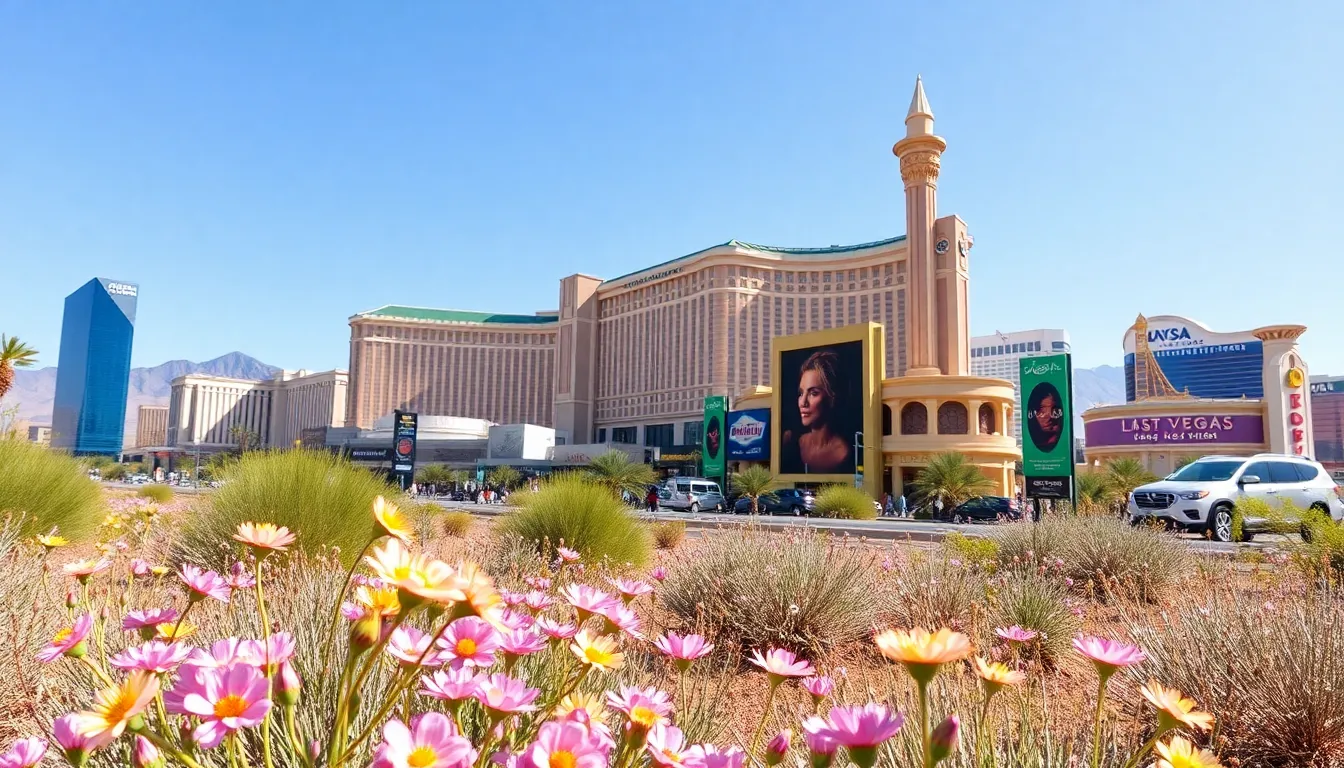Las Vegas, the city that never sleeps, is famous for its vibrant nightlife and dazzling entertainment. But what about the weather? If you’re planning a trip to this desert oasis, knowing the forecast can be just as crucial as picking the right show to see. After all, nobody wants to end up looking like a sweaty slot machine after a day in the sun!
Table of Contents
ToggleOverview of Weather Las Vegas, NV, USA
Las Vegas experiences a desert climate characterized by hot summers and mild winters. During summer months, average high temperatures often exceed 100°F, making it crucial for visitors to stay hydrated and plan activities for the cooler parts of the day. Conversely, winter temperatures range between 30°F to 60°F, which can lead to chilly evenings.
Rainfall in Las Vegas remains minimal, averaging less than 5 inches annually. Most precipitation occurs during the winter and early spring, with summer storms usually being brief but intense. Understanding these patterns helps in adequately preparing for sudden weather changes.
Humidity levels tend to be low, contributing to the dry heat in summer months. Visitors often feel the heat more intensely due to the arid conditions. Spring and fall provide the most pleasant temperatures, ranging from 70°F to 85°F, making these seasons ideal for outdoor activities.
Sunshine dominates the weather in Las Vegas, with over 300 sunny days a year. This abundance of sunlight enhances the enjoyment of outdoor attractions, though sun protection is necessary. Knowing weather trends aids in planning excursions to iconic sites, from the Strip to natural parks surrounding the city.
Las Vegas weather offers distinct seasonal characteristics, which significantly influence visitors’ experiences. Awareness of temperature ranges, rainfall patterns, and sunlight hours ensures comfort throughout any visit.
Seasonal Weather Patterns

Las Vegas experiences distinctive seasonal weather patterns that shape the outdoor experience throughout the year.
Spring Weather
Spring in Las Vegas features warming temperatures with averages ranging from 50°F to 80°F. March begins cool, while May brings consistently pleasant days. Rainfall is minimal, often totaling less than 1 inch per month. This season sees blooming desert flowers and clear skies, making it ideal for outdoor activities. Visitors frequently engage in hiking and sightseeing during spring. Sunshine predominates, offering more than 10 hours of daylight daily.
Summer Weather
Summer brings intense heat to Las Vegas, with average highs exceeding 100°F. July can be particularly scorching, often reaching up to 110°F. Nights remain warm, with temperatures rarely dipping below 70°F. Humidity stays low, which can make the heat feel more oppressive. Outdoor activities become challenging during peak daytime hours. Most visitors focus on indoor attractions or poolside relaxation to escape the heat. Despite the high temperatures, sunny days prevail throughout the season.
Fall Weather
Fall showcases increasingly mild temperatures, typically ranging from 60°F to 90°F. September retains summer warmth, while November ushers in cooler air. Rain remains infrequent, with October marking the end of the dry season. Visitors often enjoy pleasant weather ideal for exploring the Strip and surrounding areas during this transition. Autumn presents colorful landscapes as foliage changes, creating beautiful scenery. With comfortable temperatures, outdoor events flourish throughout the city.
Winter Weather
Winter in Las Vegas is characterized by mild and cool weather, averaging between 30°F and 60°F. December and January can see temperatures drop, particularly at night, making appropriate clothing necessary. Light jackets and sweaters often suffice for daytime activities. Rainfall increases slightly in winter, typically averaging 1 inch per month. Visitors may encounter occasional storms, but significant snowfall is rare. The city’s holiday festivities shine bright amid the cooler temperatures, providing a unique winter experience.
Average Temperatures
Las Vegas features distinct temperature variations throughout the year, essential for planning any visit.
Daily Highs and Lows
Daily high temperatures in Las Vegas vary significantly. In summer, highs often reach beyond 100°F, particularly in July. Conversely, winter lows can drop to around 30°F at night. The temperature difference between day and night can exceed 40°F during the hottest months. With careful planning, visitors can enjoy outdoor activities in cooler early morning or late evening hours while avoiding midday heat.
Monthly Averages
Monthly averages provide a clearer picture of temperature trends. January averages around 56°F, while July temperatures soar to an average of 104°F. Spring months see a gradual increase, with April average highs of 77°F and May reaching 90°F. Fall offers moderate temperatures, with September averaging 93°F, then dropping to 68°F by November. Understanding these averages helps visitors select the best time for outdoor excursions.
Precipitation and Humidity
Las Vegas experiences low rainfall and humidity levels, typical for its desert climate.
Rainfall Trends
Rainfall in Las Vegas averages less than 5 inches annually. Most precipitation occurs during winter and early spring months. For instance, February and March see the highest precipitation rates, with occasional thunderstorms possible. Summer months generally remain dry, contributing to the city’s arid environment. Occasional heavy downpours can occur, but these are rare, often leading to brief flooding. Visitors planning outdoor activities should monitor the forecast but expect predominantly dry conditions year-round.
Humidity Levels
Humidity in Las Vegas tends to be quite low, averaging between 10% and 30% throughout the year. Such low humidity enhances the feeling of heat during summer months. Even though the heat peaks at over 100°F, the low humidity can make it more tolerable for some. Fall and spring bring slightly higher humidity levels, creating a more comfortable outdoor experience. Understanding these humidity patterns allows visitors to prepare appropriately for outdoor adventures, ensuring a more enjoyable stay in Las Vegas.
Extreme Weather Events
Las Vegas faces various extreme weather events that can impact residents and visitors.
Heatwaves
Heatwaves frequently affect the area during the summer months. Average high temperatures often soar above 100°F. The most intense heat usually occurs in July, where it’s not uncommon to experience multiple consecutive days of extreme temperatures. These prolonged periods of heat can lead to heat-related illnesses, particularly for those engaging in outdoor activities. Staying indoors during peak hours is crucial for safety. Visitors can also benefit from wearing light clothing and consuming plenty of water. Recognizing the signs of heat exhaustion aids in avoiding severe health issues.
Flooding
Despite its desert climate, Las Vegas experiences occasional flooding. Most rainfall occurs in the winter, contributing to flash floods during thunderstorms. February and March often witness brief but intense storms that can overwhelm drainage systems. Even light rainfall can lead to swift flooding in low-lying areas. Visitors should be aware of weather forecasts to anticipate potential flooding. Local authorities often issue advisories during severe weather events to ensure public safety. Planning for alternative routes helps avoid flood-prone areas during such conditions.
Understanding the weather in Las Vegas is key to making the most of a visit. With its desert climate visitors can enjoy sunny days for most of the year but need to be prepared for the intense heat during summer. The mild winters offer a unique charm that shouldn’t be overlooked.
By staying informed about temperature fluctuations and seasonal changes travelers can plan outdoor activities more effectively. Whether it’s exploring the vibrant spring blooms or enjoying the cooler fall evenings knowing the weather patterns enhances every experience in this iconic city.





